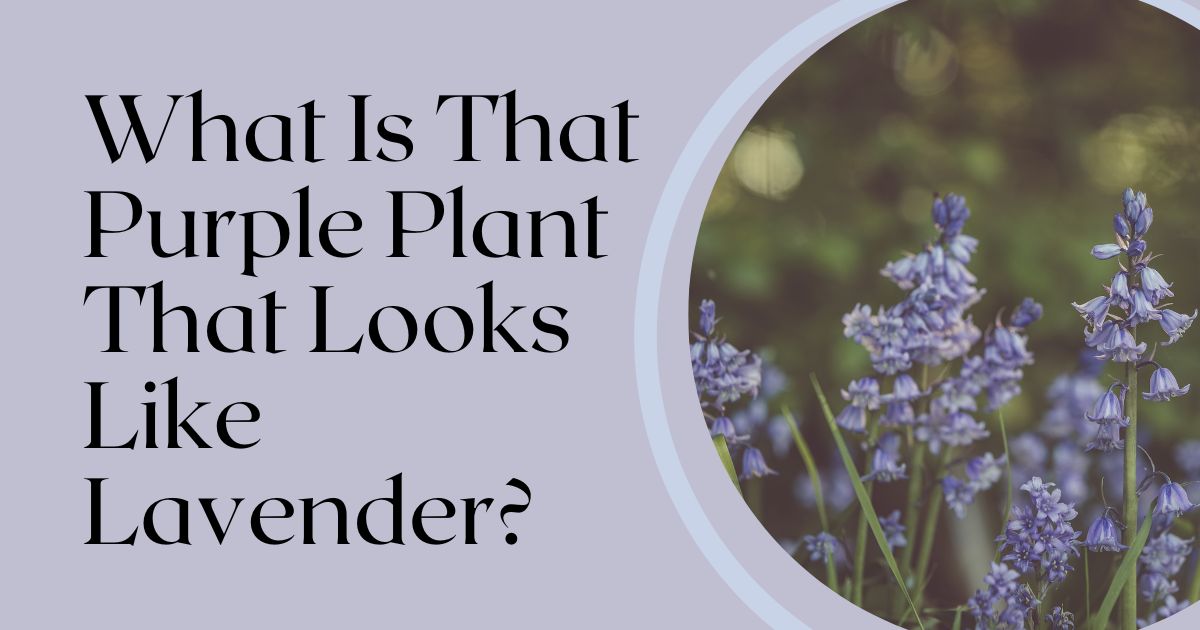Lavender is by no means one of the most desired but demanding decorative plants. It makes one think of a purple plant that looks like lavender but is less erratic.
Luckily, many different plants are no less beautiful and fragrant to decorate one’s house.
The following article can help one choose the perfect plant that will become a decent substitute for high-maintenance lavender.
Lavender Plant Lookalikes
It is incredible how many flowers look like lavender. No less than twelve plants resemble lavender, and their properties are equally impressive.
As one dives deeper into the issue, it becomes clear that most lookalikes come from the same family as lavender, explaining their similarities.
If one confuses some of these plants for lavender, they will still have a beautiful and fragrant decoration.
Other Purple Plants That Look Like Lavender
Basil (Ocimum Basilicum)
Basil comes from the Lamiaceae mint family. Usually, basil has a purple leaf color in all seasons except winter. Lavender also has a light green color in winter, so it is still possible to confuse them.
Furthermore, lavender and basil have small purple flowers on their stems, making it harder to tell them apart.
The same colors are not the only features common for basil and lavender. Both plants grow well in sand and loam and release an aromatic fragrance.
However, while lavender has small, narrow, and short leaves, basil has oval. So, it is possible to confuse them only if one has never seen either lavender or basil.
Regardless of differences, basil is not less extraordinary. Basil is a sacred plant in India, associated with Hindu gods Vishnu and Krishna. And for Jews, wearing a piece of basil as a garland means easier fasting.
Catmint (Nepeta)
Catmint is another plant one can easily confuse with lavender. Just like basil, it comes from the same mint family. Native to Europe and Asia, catmint inhabits some parts of North America.
Being a perennial herb (meaning it does not require manual replanting), catmint can grow up to 2 or 3 feet tall (61 to 91 cm).
Lavender, on the other hand, grows as tall as one to two feet (30 to 61 cm). However, occasionally it grows no smaller than 5 feet tall (152 cm), but it rarely happens in domestic conditions.
As for the leaves, catmint is more similar to basil than lavender, having a broader leaf shape.
Still, what makes one look twice is the color. Just like lavender, catmint has similar beautiful purple flowers. In some cases, densely growing flowers of catmint can hide the leaves, so it is difficult to tell them apart from lavender.
Not only pretty, but catmint is also great for herbal teas, especially ones that treat digestive problems. Catmint tea also reduces stress and anxiety.
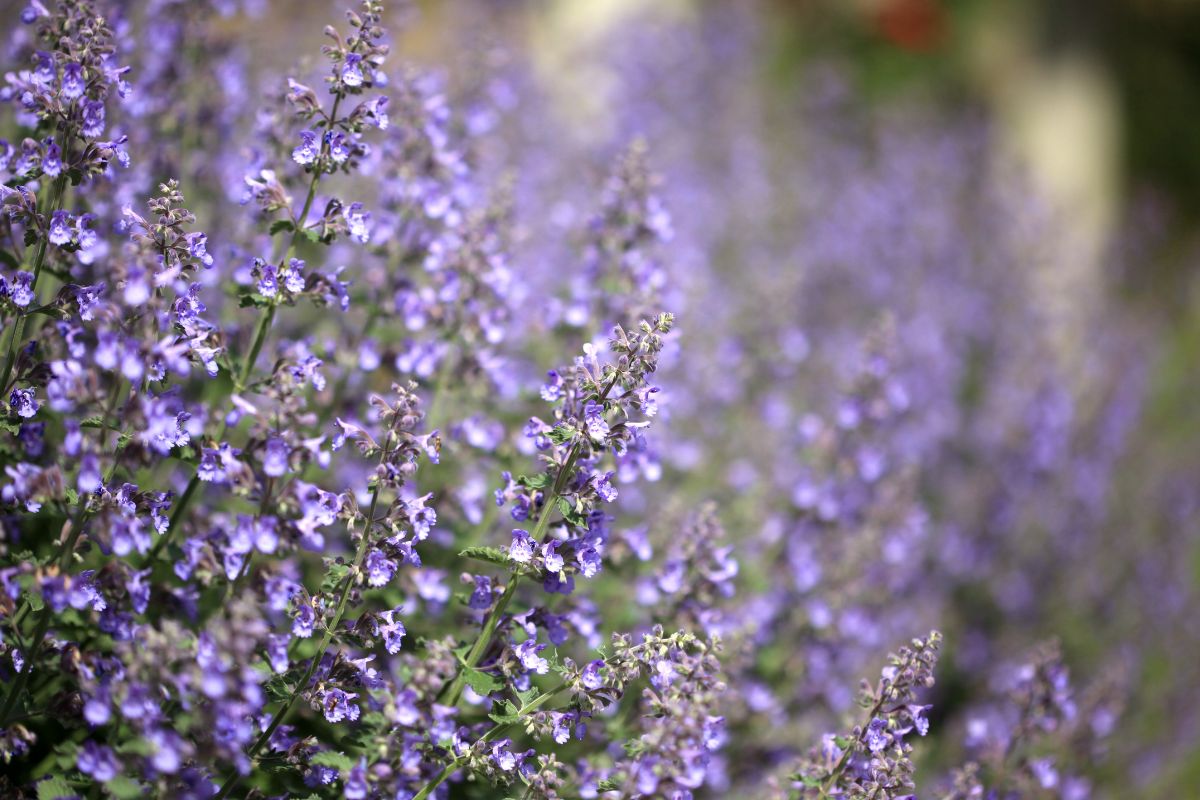
Catnip (Nepeta cataria)
Despite having a similar name to catmint, catnip is slightly different.
Catnip has a distinct appearance, different from its counterpart. What makes catnip special from lavender is the leaf shape. Catnip has toothed gray-green heart-shaped leaves.
On top of that, catnip has small pink or white flowers instead of rich purple flowers. Interestingly, lavender has not only purple but white lavender (Lavandula angustifolia). So, it is no wonder catnip comes up as an “evil twin.”
Nevertheless, catnip is a strong contestant itself. For example, catmint is a common sedative for excitable cats. But catnip does the opposite by making them more energetic, sometimes even euphoric.
Still, just like catmint, catnip is great for soothing the digestive system. In some traditions, catnip tea is a common medicine for relieving infants’ colic and helping them sleep.
Holy Basil (Ocimum Tenuiflorum)
Once again, an “evil twin” to another contestant. Similar to catmint and catnip, basil and holy basil do share similarities. Still, some distinctions deserve attention.
Both basil variants come from the same Lamiaceae family. However, their origins are different.
Holy basil comes from Southeast Asia and is a common ingredient in traditional Indian medicine, unlike usual basil. The medicinal properties of holy basil stretch from relieving insect bites to treating bronchitis or even managing symptoms of ADHD (attention deficit hyperactivity disorder).
On the other hand, despite practical differences, basil and holy basil are similar visually. And this is where lavender comes onto the stage.
Like in the case of basil, holy basil has distinct leaves. They are not as plump as basil and have a more ragged look.
Holy basil also requires similar conditions as basil. This plant loves generous watering and well-drained soil.
However, what makes holy basil a mighty contestant is the flowers. The tiny purple flowers, sometimes magenta, cover the plant’s stem. They are not as rich as lavender but may confuse nevertheless. After all, lavender can also have a different look if mistreated.
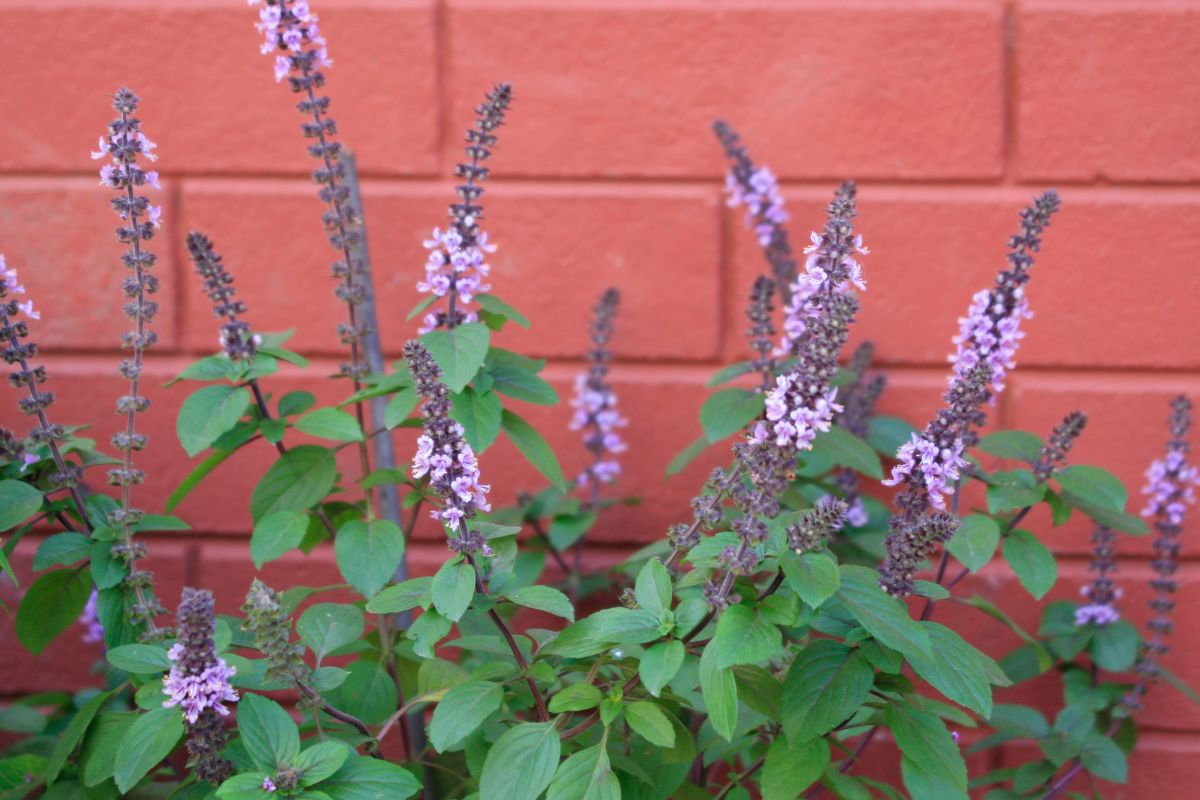
Hyssop (Hyssopus officinalis)
Hyssop is another purple plant that looks like lavender. Like the other plants mentioned above, hyssop comes from the Lamiaceae family.
Like its “family members,” hyssop is an aromatic perennial herb. One hyssop’s variety – anise hyssop (Agastache foeniculum) – is native to the United States. Still, the Hyssopus officinalis first appeared in Europe.
Lavender, on the other hand, does not divide into varieties. Lavandula angustifolia is the only known form of lavender, originating in the Mediterranean region of Europe.
However, unlike basil or catmint, there are more similarities between lavender and hyssop, making it difficult to distinguish the two.
To start with, both plants share similar-looking leaves. Hyssop has short and sharp leaves, and lavender leaves look the same. However, the latter is still long and not as green as hyssop’s leaves.
As for the flowers, hyssop has an active period of altering colors. The hyssop flowers acquire violet-blue, pink, or white shades in summer. Lavender has summer periods of bloom as well, which means different colors. This finding may confuse an average person without sufficient knowledge.
The hyssop flowers and lavender have a similar length, making it difficult to tell them apart. The average hyssop flower grows up to 16 inches (around 41 cm) – the same size is available for lavender.
However, the flavor can help separate two plants from each other. Hyssop has a strong mint flavor mixed with some lavender-resembling notes. Those who know the smell describe it as somewhat bitter with a trace of turpentine.
To sum up, lavender and hyssop are very similar, so the smell is what will help one find to tell them apart.
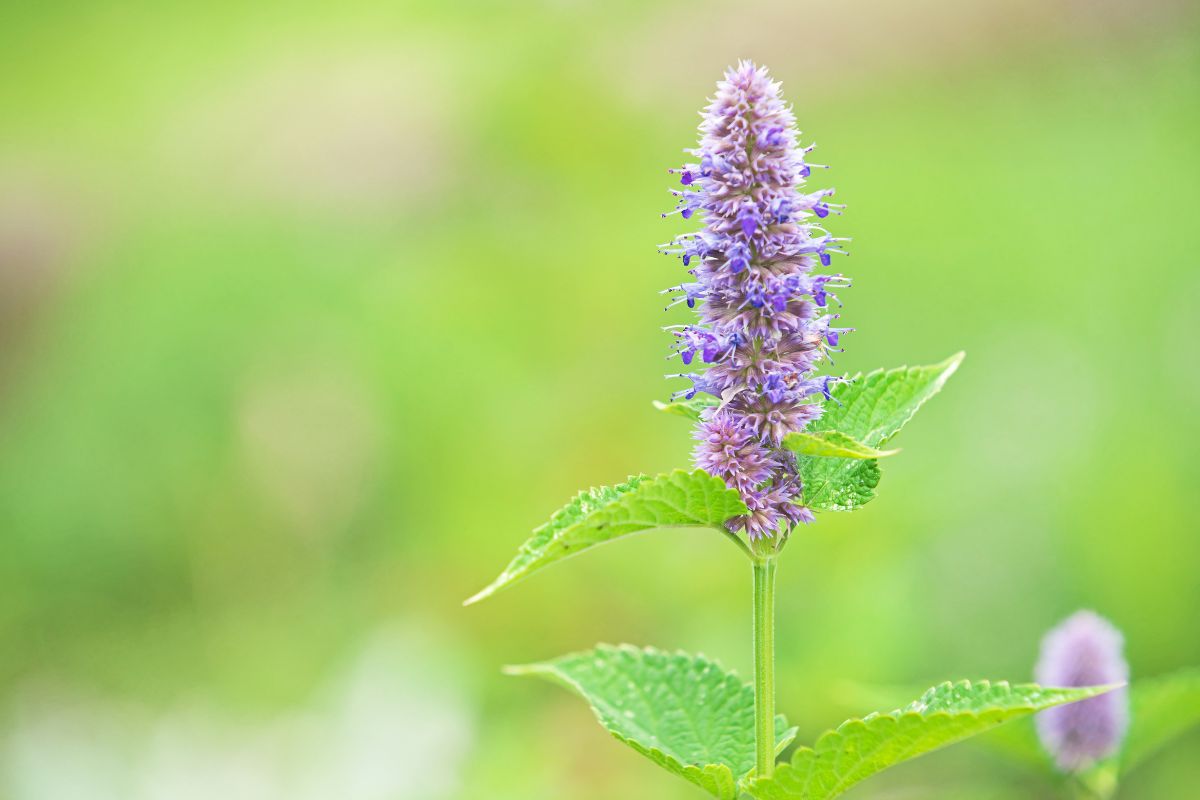
Meadow Sage (Salvia nemorosa)
Meadow sage is that purple flower plant that is more confusing than all other plants. It is an ornamental herb from the Lamiaceae family. Considering it belongs to the same family as lavender, it is no wonder both plants are similar.
Being a perennial upright plant, meadow sage has a stem covered in soft hairs, which is its distinct feature. Notably, the stem of meadow sage contains essential oils, which is not possible for lavender.
Both lavender and meadow sage have a similar form of the leaf. The leaves in both plants are long and have a gray-green color. However, the major difference is the wrinkles around the edges of leaves in meadow sage.
Also, unlike the pleasant smell of lavender, the leaves of meadow sage have a bad odor.
The flowers of both plants are also similar. The meadow sage flowers are usually small and have a purple or bluish-purple color.
Still, meadow sage is an excellent alternative for outdoor purple plants. It is beautiful, and the stem’s odor scares off rodents.
Pitcher Sage (Salvia azurea)
Pitcher sage is a gentle plant that looks like lavender but isn’t when one takes a second look.
Native in North America, pitcher sage is a member of the mint family.
Unlike lavender, which prefers growing up in an open space, pitcher sage tends to pop up in dense clusters.
The average height of pitcher sage – around 4 feet (122 cm) – also distinguishes it from lavender. In other words, pitcher sage seems more stable than its lookalike.
Both plants have distinct visual elements as well. The pitcher sage and lavender leaves are erect yet soft, with a furry stem keeping all intact. However, the leaves of lavender are smooth, unlike pitcher sage with hairy petals.
The colors are similar in both plants, or it would be easy to tell them apart— pitcher sage includes a range of white to deep purple flowers.
Like in the previous case, the smell can help distinguish two plants. Pitcher sage has a scent of camphor, while lavender smells sweeter. Such a distinct contrast will undoubtedly help.
Purple Salvias (Salvia officinalis)
Purple salvia is a famous purple flower that looks like lavender. These flowers share so much in common that it is no surprise one can find it difficult to tell them apart.
First, both flowers are perennial herbs and are the most common plants in their genus. They are also native to the Mediterranean and are common ingredients of local cuisine and medicine.
Like lavender, purple salvias have beautiful and fragrant leaves. The stem’s color is usually gray, resembling a lavender stem.
Salvias also grow lavender purple flowers with blue variations. Considering lavender also has purple and blue flowers, one may not guess which one is which at first.
However, the shape of the flowers will give away the purple salvias. Unlike the tubular flowers of lavender, salvia has two-lipped flowers.
Still, both flowers are uniquely aromatic, so keeping purple salvias at home is not a bad idea.
Purple Giant Hyssop (Agastache scrophulariifolia)
Purple giant hyssop is also known as prairie hyssop. Like regular hyssop, this purple plant that looks like lavender is a perennial herb of the mint family.
Interestingly, the plant can grow up to 6 feet (183 cm) tall for its family, hence the name.
Similar to lavender, prairie hyssop has aromatic foliage. The plant’s upper branches can have a purplish color, not as deep as in lavender, yet still noticeable.
Both plants have erected stems and flowers, which may confuse an amateur devotee or florist.
However, the flowers of prairie hyssop develop a little differently from lavender. Initially spikes, their tops develop into a flower and group into clusters with other spikes. It is not typical for lavender, which should help tell the plants apart.
Rosemary
Rosemary is the first plant on the list that does not belong to the mint family. Native to the Mediterranean region, this purple flower plant is an herbaceous shrub, traditional in cooking.
However, rosemary is also an element of decoration thanks to its delicate flowers. Similar to lavender, it displays different colors in the summer period when it blooms. The most common colors include white, blue, pink, and purple flowers.
However, what can help tell rosemary apart from lavender are blooming periods and the length. Usually, rosemary blooms in late spring to early summer. At the same time, lavender starts blooming as early as the beginning of spring and can last till the late summer.
As for the length differences, the average growth range of length for rosemary is from2 to 6 feet (61 to 183 cm). Lavender does not usually grow so tall, although there are extraordinary exceptions.
Russian Sage (Perovskia atriplicifolia)
If one had to compare Russian Sage to lavender, one could describe it as lavender’s wild sibling.
Coming from the dry steppes of central Asia, Russian Sage has been an element of local folk medicine for a long time.
Unlike lavender, it is a very drought-tolerant plant that needs delicate watering.
However, Russian Sage indeed shares many features with lavender. Starting with appearance, both plants have prolonged erect stems with deep purple flowers covering them along the length.
Sharp dark green leaves are also typical for Russian Sage and lavender. Furthermore, the foliage of both plants is scented, making it even more challenging to differentiate.
Blooming from the summer, Russian Sage grows from 2 to 3 feet (61 to 91 cm), resembling lavender exceptionally well.
The manner of growth can help tell them apart – Russian sage grows in small bushes, while lavender prefers free space.
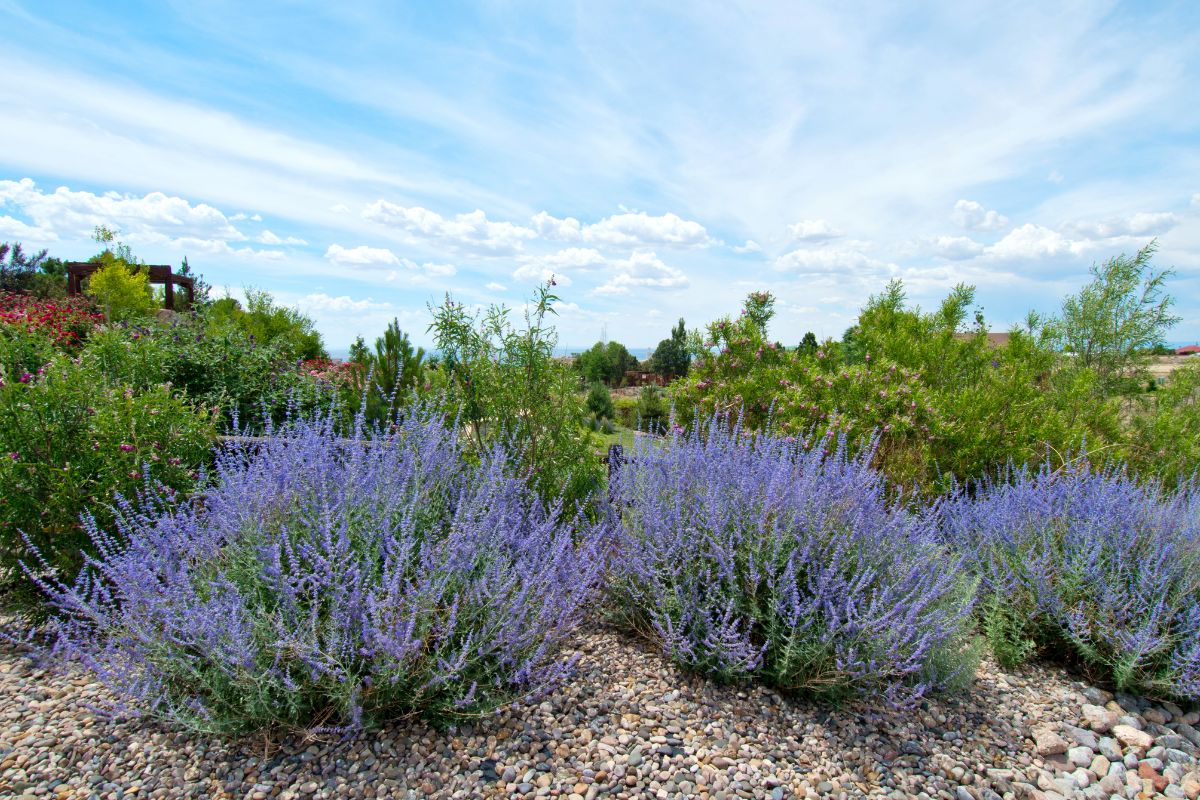
Wisteria
Finally, the last plant with purple flowers confuses the viewer. Delicate and elegant, this flower is a typical decoration of gardens. Wisteria is native to Southeastern Asia and the Eastern United States and grows on forest edges and river sides.
At first glance, wisteria and lavender share many elements. There is even a sort of wisteria called ‘Lavender Lace’ that produces fragrant purple, pink, or violet flowers in late spring or early summer. Read our article and find out What Temperature Is Too Cold For Plants?
But unlike lavender, wisteria grows in vines, which points it out among other plants on the list.
However, like lavender, this plant needs a lot of space to grow and spread out. They also love water and require well-drained soil to blossom.
Despite looking alike, wisteria and lavender are pretty easy to tell apart. And even if one buys wisteria, they will not regret it.
FAQs on Lavender Lookalikes
Is Russian Sage a Type of Lavender?
No. Russian Sage is not a type of lavender. One can confuse them because both plants belong to the mint family (Lamiaceae). And, of course, they have similar appearances.
Is Wisteria and Lavender the Same?
No, those two plants are not the same thing. Wisteria is a pea family member, while lavender is from the mint family. They both have aromatic flowers, but the structure of their stems and leaves is different.
Are Sage and Lavender Related?
It is true lavender and sage are related. To start with, both plants are members of the mint family. It is the reason why they share a strong fragrance popular in aromatherapy.
Nevertheless, sage and lavender also have differences. Lavender acquires a more floral scent, while sage has a more bitter and piquant aroma.
In culinary, lavender is a common ingredient in sweet dishes, and sage fits the savory ones the most.
What does lavender look like when it starts to grow?
Usually, lavender starts growing in spring. The future green leaves sprout in a spiral manner. In the center, a small bud grows slowly and later becomes a lavender flower. Usually, the flowers acquire a deep purple color and a strong, elegant aroma.
Lavender is a common ingredient in essential oils, sachets, and potpourris. Not only that, the beauty industry finds lavender a very valuable plant.
Recap
To sum up, lavender is entirely replaceable for those with no time and patience to take care of it.
It is even better – the variety of lavender lookalikes will give plenty of space to experiment with their visual and aromatic characteristics and find the flower that suits one’s taste the most.
The list of flowers in this article showed how different flowers from around the world could be a beautiful addition to one’s house, even when not the first choice.
It is also a great deal for those who have no lavender in their local flower shops but want to grow something no less aromatic and eye-pleasing. In the end, there are no unsolvable situations regarding flowers.
